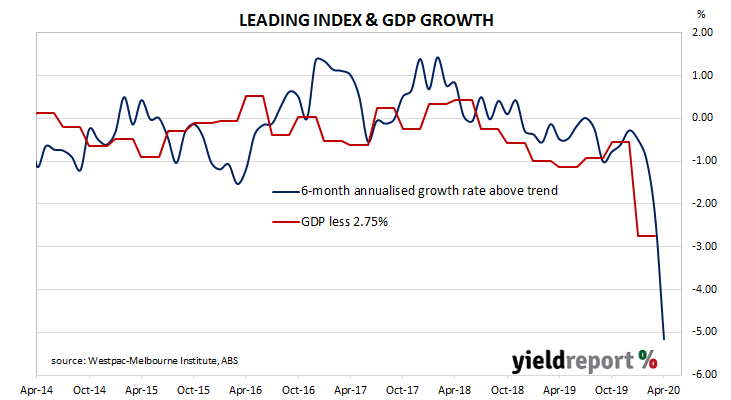Summary: Leading index fall worse than March drop; implies GDP growth to fall to ~-2.5% later this year; index growth rate likely to recover as restrictions removed.
Westpac and the Melbourne Institute describe their Leading Index as a composite measure which attempts to estimate the likely pace of Australian economic activity over the next three to six months. After reaching a peak in early 2018, the index trended lower through 2018, 2019 and the early months of 2020. A sharp drop came as expected in March as various sectors of the economy were mothballed and restrictions on individuals’ movements came into force. Westpac’s chief economist hinted at that time April’s reading would probably be worse.
The latest reading of the six month annualised growth rate of the indicator has fallen from March’s revised figure of –2.34% to -5.16% in April. After a brief improvement at the end of 2019, the index deteriorated in both January and February before a (smaller) plunge in March.
Westpac chief economist Bill Evans said, “The signal points to a broad-based economic contraction.” He noted it was “the weakest reading since the GFC” and comparable to readings seen prior to all previous recessions going back to 1960. What’s more, he said the speed of the index’s fall was “unprecedented”.
Index figures represent rates relative to trend-GDP growth, which is generally thought to be around 2.75% per annum. The index is said to lead GDP by three to six months, so theoretically the current reading represents an annualised GDP growth rate of around -2.50% sometime in the second or third quarters of 2020.
Long-term Commonwealth Government bond yields finished lower, largely in line with falls in US markets overnight, while the 3 year yield remained just above the RBA’s 0.25% target rate. By the end of the day, the 3-year ACGB yield remained unchanged at 0.26% but the 10-year yield had lost 3bps to 0.94% and the 20-year yield finished 4bp lower at 1.53%.

